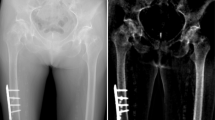Abstract
The conventional analysis of ballistic gelatine is performed by transillumination and scanning of 1-cm-thick slices. Previous research demonstrated the advantages of colour and radio contrast in gelatine for computed tomography (CT). The aim of this study was to determine whether this method could be applied to head models in order to facilitate their examination. Four head models of about 14 cm in diameter were prepared from two acryl hollow spheres and two polypropylene hollow spheres. Acryl paint was mixed with barium meal and sealed in a thin foil bag which was attached to the gelatine-filled sphere which was covered with about 3-mm-thick silicone. The head models were shot at using 9 mm × 19 expanding bullets from 4 m distance. The models were examined via multislice CT. The gelatine core was removed; the bullet track was photographed and cut into consecutive slices which were scanned optically. CT images were processed with Corel Photo-Paint. Optical and radiological images were analysed using the AxioVision software. The disruption of the gelatine within the head model was visualised by extensive distribution of paint up to the end of the finest cracks and fissures and along the whole bullet track. CT imaging with excellent radio contrast in the gelatine cracks caused by the temporary cavity allowed for multiplanar reconstruction. We conclude that the combination of colour contrast in gelatine with contrast material-enhanced CT facilitates accurate measurements in ballistic head models.












Similar content being viewed by others
References
Schyma C (2010) Colour contrast in ballistic gelatine. Forensic Sci Int 197(1–3):114–8
Schyma C, Madea B (2012) Evaluation of the temporary cavity in ordnance gelatine. Forensic Sci Int 214(1–3):82–7
Schyma C, Hagemeier L, Greschus S, Schild H, Madea B (2012) Visualisation of the temporary cavity by computed tomography using contrast material. Int J Legal Med 126(1):37–42
Fackler ML, Malinowski JA (1985) The wound profile: a visual method for quantifying gunshot wound components. J Trauma 25:522–529
Korac Z, Kelenc D, Hancevic J, Baskot A, Mikulic D (2002) The application of computed tomography in the analysis of permanent cavity: a new method in terminal ballistics. Acta Clin Croat 41:205–209
Rutty GN, Boyce P, Robinson CE, Jeffery AJ, Morgan B (2008) The role of computed tomography in terminal ballistic analysis. Int J Legal Med 122(1):1–5
Bolliger SA, Thali MJ, Bolliger MJ, Kneubuehl BP (2010) Gunshot energy transfer profile in ballistic gelatine, determined with computed tomography using the total crack length method. Int J Legal Med 124:613–6
Acknowledgments
We wish to thank Dr. Courts for critical discussion and lecturing.
Conflict of interests
None
Author information
Authors and Affiliations
Corresponding author
Rights and permissions
About this article
Cite this article
Schyma, C., Greschus, S., Urbach, H. et al. Combined radio-colour contrast in the examination of ballistic head models. Int J Legal Med 126, 607–613 (2012). https://doi.org/10.1007/s00414-012-0704-8
Received:
Accepted:
Published:
Issue Date:
DOI: https://doi.org/10.1007/s00414-012-0704-8







